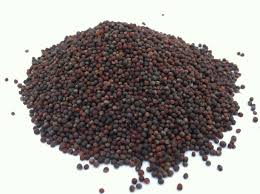
Canola oil can get a pretty bad rap sometimes. You may hear that it’s solvent expelled with chemicals… Or that it’s made from seeds that start with the word “rape”… That alone and it’s not looking too good for canola oil!
Here’s the thing: the poor reputation typically comes from information about conventional oils in particular — how they’re made, where they come from and misinformation about where the seeds originated from. The same information that applies to conventional canola doesn’t necessarily apply to non-gmo and organic canola, and THIS is exactly where the confusion can set in.
Non-gmo and organic versions of canola oil are typically healthier, expeller pressed versions that use no chemical solvents to produce the oil. A lot of the downsides of canola oil that some people claim drastically diminish when you look at organic or non-gmo canola oil, so I think it’s only fair to look at the whole picture.
Today, I’d like to explain some of the differences between organic and non-organic (also known as conventional or RBD) canola oil. These oils can be radically different in how they’re made and what they’re made from.
Organic vs. Non-Organic Oils: Are They Really That Different?
First off, let’s take a step back. Across the board, are ALL oils really that different when you compare the organic vs. the non-organic versions of them? Well, the answer really depends on the oil.
Non-organic Extra Virgin Olive Oil, for example, is very similar to its organic counterpart. It is produced in the exact same way, making an almost identical tasting oil. In addition, pesticides aren’t commonly used on olive trees, so the way the olives are grown is very similar as well. All in all, organics vs. non organic extra virgin olive oils are very similar.
Other oils — in particular seed oils like canola, soybean and sunflower oil — can be VERY different in how their organic vs. non-organic counterparts are made, and whether the seeds are non-gmo and/or organic, or not. Let me explain more below.
The History Of The Canola Plant (Please Read, It’s Important!)
First off, let’s talk about the canola plant. This history is important: a key misunderstanding that people have about canola oil is that it can’t be organic or non-gmo because it was genetically modified from a rapeseed plant to become a canola plant. They believe that being genetically modified is a basic pre-requisite for existing. This is not true, and is a misunderstanding of the timeline of events and what occurred.
The canola plant is a “distant younger cousin” of the rapeseed plant. The rapeseed plant was originally grown to make meal for cows in the latter half of the 20th century. Rapeseed plants naturally had mid-to-high levels of eurcic acid, which is a component of each fat molecule. A ruminant cow can easily ingest this eurcic acid in its 4 stomachs, but the human digestion can’t take much of it.
Don’t think of eurcic acid as a bad thing just because of the word “acid” — all oils come with many different kinds of fatty acids. Oleic acid, for example, is another term for healthy monounsaturated fats that are found in olive oil and avocados.

In the 70s, scientists and farmers worked to produce a similar plant that had much lower levels of eurcic acid for people to use and eat. This new low-eurcic acid plant, they renamed canola oil (because, let’s be real, who would have chosen the name “rapeseed” to begin with? To me, it’s an unfortunate choice). The new name came from the acronym CANadian Oil Low Acid… CAN-O-L-A.
This new canola plant was developed using traditional breeding methods (think Gregor Mendel’s pea plant experiment). Another way to look at it is by looking at other traditional breeding methods, like the way animals and humans pass traits through generations. In this example, if you breed a brown chicken with a white one, you can create a speckled white and brown chick. Then you breed that speckled brown & white chicken, once grown, to a white chicken to a create an even-more-white-speckled chicken. Aka, it’s selective breeding but done naturally. However, it’s important to not that genetic modification wasn’t extensively used yet at this point back in the 70s!
For the next few decades, the use of canola oil and meal grew throughout the US and Canada. Then, in the 90s, genetic modification became a very popular new thing. Farmers wanted higher yields and they took these seeds (already canola seeds at this point) and genetically modified them to make them resistant to RoundUp. Soon almost all of the canola in the US was genetically modified; in recent years, over 96% of canola crops were GM — this number is now slowly dropping.
However, there were still those original seeds floating around, produced through traditional breeding back in the 70s that were never touched by genetic modification.
These seeds became the mainstay used for non-gmo and organic canola oil production today. This is the first key difference between organic vs. non-organic canola. Organic canola oil (and non-gmo canola oil) uses the original seeds from the 70s, while the non-organic canola uses the newer genetically modified versions.
How Non-Organic (Conventional/RBD) Canola Is Produced
 Non-organic (or conventional) canola oil is made from the seeds of the genetically modified canola plant.
Non-organic (or conventional) canola oil is made from the seeds of the genetically modified canola plant.
These seeds are collected from the plant and solvent expelled. This means that a chemical solvent, usually hexane, is added to the seeds. This chemical process draws the oil out of the seed, rather than physically squeezing it out (like you would squeeze water out of sponge).
The oil is then processed using an RBD process (refined, bleached and deodorized). To learn more about that exact process, we suggest reading the following article: What Does RBD Mean, In Relation To Bulk Oils?
How Organic Canola Is Produced Differently
As we mentioned above, organic canola oil uses the original canola seeds that were traditionally bred before genetic modification was common. These plants have never been genetically modified, which allows the 3rd party auditor, The Non-GMO Project Verification, to apply their butterfly seal to this oil.
Organic canola oil is also expeller pressed. Solvents like hexane are not organic, and are not allowed to be used in organic oil production. Therefore, this oil is expeller pressed by physically squeezing the oil out of the seed. This avoids the use of chemical solvents to produce this oil.
Lastly, this oil does still undergo an organic version of the refining process (similar to the above, typically a high heat process). This makes the oil both light in color and flavor.
Comparing The Final Oils
When you taste the organic vs. non-organic canola oils side by side, they are going to be essentially identical. They will taste the same and look the same. And luckily for organic food manufacturers, they should work exactly the same in your products.
Inside the oil, however, the organic version is going to be produced very differently than the conventional canola oil: it avoids solvent extraction and is made with non-gmo seed. Not exactly apples to apples if you are looking for an oil for your natural food product!
Topics: Canola Oil












